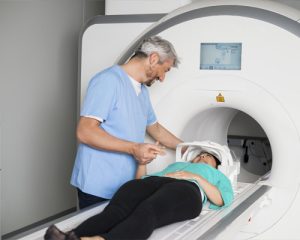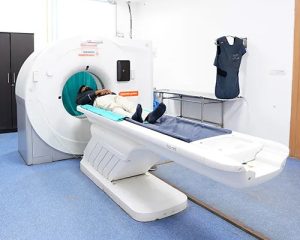Nuclear Medicine
June 3, 2025 by adminNuclear Medicine: Diagnostic Procedures and Therapeutic Applications
 Learning Objectives:
Learning Objectives:
- Understand the principles of nuclear medicine, including radionuclide imaging and targeted radiotherapy.
- Identify major diagnostic procedures including PET and SPECT, as well as their clinical applications.
- Understand nuclear medicine procedures from the clinical perspective through well-detailed case studies.
- Review recent changes in treatment approaches, including theranostics, and discuss their implications in managing patients.
- Consider how to develop principles to combine diagnostic and therapeutic procedures into standard clinical practice for better patient care.
Introduction
Nuclear medicine stands at an exciting confluence of science and medicine by way of applying radiopharmaceuticals to diagnose and treat diseases. In contradistinction to traditional means of imaging, nuclear medicine techniques fill the critical role of providing functional and molecular information hidden from the very understanding of disease pathophysiology. Today, with ever-greater advances in imaging techniques and targeted radiotherapy, nuclear medicine acts as a pillar in the diagnosis of ailments of an oncological, neurological, cardiovascular, and infectious nature.
The evolution of the discipline has been driven mostly by a multitude of advances in radiopharmaceuticals, instrumentation, and computer-aided diagnostic algorithms. Nuclear medicine, with its accurate dose administration and high spatial resolution image-forming capability, not only localizes pathology but also measures biochemical processes for early diagnosis and treatment monitoring. In view of this, the authors intend for this article to provide health professionals with the relevant technical knowledge on diagnostic procedures and therapeutic applications in nuclear medicine, integrated with applied case studies.
Procedure Description
Diagnostic Imaging Procedures
Positron Emission Tomography (PET) and Single-Photon Emission Computerized Tomography (SPECT) constitute the two most commonly used imaging modalities in nuclear medicine. Both function based on the unique properties of radionuclides, with their mechanisms and clinical applications being utterly different.
Positron Emission Tomography (PET): In PET imaging, positron-emitting radiotracers (such as 18F-FDG) are introduced into the body, and they concentrate in areas of high metabolism. When the positrons collide with electrons, the two photons are sent out in exactly opposite directions, so it is possible to accurately pinpoint where the higher metabolic activity is located. PET is widely used to detect and stage tumors in oncology and to assess cerebral metabolism and myocardial viability in neurology and cardiology, respectively.
Single-Photon Emission Computed Tomography (SPECT): In contrast, SPECT uses gamma-emitting radionuclides (e.g. 99mTc, 123I) with gamma cameras to map the three-dimensional images. SPECT is especially suited for the assessment of cerebral blood flow, cardiac perfusion, and bony metabolism. The growing application of SPECT/CT hybrid imaging further enhances anatomical localization, contributing towards finer classification in diagnosis. Integrating the CT component with SPECT serves to allow the maximum information content through a synthesis of functional and morphological details, which is crucial for planning the appropriate intervention.
Therapeutic Procedures
With the improvement in diagnostic techniques have come considerable advances in therapeutic nuclear medicine, especially with targeted radionuclide therapy. For example, Radioiodine Therapy for thyroid disorders and Peptide Receptor Radionuclide Therapy (PRRT) for neuroendocrine tumors have completely changed the treatment landscape.
Radioiodine Therapy: The fundamental means of treating thyroid conditions, Radioiodine Therapy takes advantage of one of the thyroid’s basic functions: absorption of iodine. Patients absorb a certain known quantity of radioactive iodine, i.e., 131I, which is slowly concentrated in the thyroid tissue, thus delivering cytotoxic radiation to the thyroid cancer cells and hyperfunctioning thyroid nodules. With this targeted delivery of radiation, there is less harm to the adjacent tissues.
Peptide Receptor Radionuclide Therapy (PRRT): PRPRT is an innovative method by which radiolabeled peptides (such as 177Lu-DOTATATE) are delivered to neuroendocrine tumors expressing somatostatin receptors. Within the bound radiopeptide, the receptor internalizes, delivering severally therapeutic radiation directly into the tumor cell. This treatment has shown promising results in patients with advanced tumors, maintaining a balance between efficacy and toxicity.
Theranostics: A novel combination of diagnostics and therapeutics, theranostics encompasses simultaneous or sequential application of a diagnostic test with a therapeutic intervention. For example, one might perform diagnostic imaging with 68Ga-DOTATATE PET to evaluate receptor density prior to pursuing 177Lu-DOTATATE for therapy. Such strategies epitomize a personalized approach to medicine wherein treatments are tailored according to the underlying tumor biology and receptor expression profiles.
 Case Studies
Case Studies
Case Study 1: PET Imaging in Oncologic Diagnosis
Patient Background: Background of the Patient: He is 58 years of age and presented with unexplained weight loss, fevers, and generalized weakness. Preliminary CT scan showed equivocal lesions in the thoracic cavity.
Diagnostic Approach: An 18F-FDG PET scanning was performed to distinguish between benign and malignant processes. The PET images demonstrated focal areas of radiotracer uptake in the lung parenchyma and mediastinal lymph nodes. On quantitative analysis, SUVs were seen to be significantly higher than the background level, indicating a high metabolic rate that would be expected in malignant tissue.
Impact on Clinical Management: The biopsy that confirmed non-small cell lung carcinoma (NSCLC) was guided by the PET findings. This high diagnostic accuracy of the PET enabled its use in early therapy, which is important for a better long-term prognosis. This case exemplifies the use of metabolic imaging as part of the diagnostic trajectory, with PET being used in oncologic staging, treatment planning, and monitoring disease progression.
Case Study 2: SPECT Imaging and Cardiac Perfusion
Patient Background: The 65-year-old woman had a history of coronary artery disease with symptoms of intermittent chest pain and breathlessness. The clinical picture was ambiguous; stress tests were inconclusive.
Diagnostic Approach: A gated SPECT myocardial perfusion imaging examination began with the administration of 99mTc-sestamibi. The SPECT images, under stress, showed major perfusion defects in the anterior and lateral walls of the myocardium, which were partly reversible on rest images. Quantitative analyses, coupled with gated parameters, gleaned information about global left ventricular function and regional wall motion.
Impact on Clinical Management: The SPECT evidence suggested ischemia in selected myocardial territories, prompting the cardiologists to proceed with coronary angiography. The angiographic results confirmed the SPECT evidence, and subsequent PCI was successful. This highlights the role of SPECT not only in the initial diagnosis but in risk stratification and guiding interventional procedures.
Case Study 3: PRRT in Neuroendocrine Tumors
Patient Background: The patient, a 47-year-old female, was diagnosed with metastatic neuroendocrine tumor (NET) upon her presentation with unremitting abdominal discomfort and spells of flushing. Conventional imaging showed diffuse metastatic spread, thus limiting treatment options.
Diagnostic Approach: The patient underwent 68Ga-DOTATATE PET/CT imaging, which showed high somatostatin receptor expressions at several metastatic sites. Such functional imaging was important not only for establishing the diagnosis but also for the quantitative assessment of receptor density to determine the feasibility of receptor-targeted therapy.
Therapeutic Intervention: As per imaging results, PRRT with 177Lu-DOTATATE was started. After various cycles of treatment, repeat imaging showed a marked decrease in tumor burden and the patient’s quality of life greatly improved. PRRT in this instance therefore exemplified the quintessential personalized and targeted therapies utilizing nuclear medicine for diagnosis and therapy in tandem.
Summary
In essence, nuclear medicine continues to be transformed in the current management of clinical conditions. The advent of integrated diagnostic techniques using PET and SPECT provides invaluable insight into the metabolic and physiological processes occasioning clinical disease. Quantification and localization of functional abnormality allow one incomparable advantage in the detection and staging of early cancers, also applicable to cardiovascular and neurological abnormalities.
The therapeutics have undergone substantial evolution over the past decades with emphasis being placed on targeted radionuclide therapy for intricate cases. Theranostics personifies the paradigm shift to precision medicine, where diagnostic imaging is coupled with therapeutic intervention to develop treatment strategies best suited for the patient via molecular details.
The case studies in this article provide real-world examples illustrating the multiple facets of nuclear medicine applied in diagnosis and therapy. From PET imaging in oncology to SPECT in cardiology to PRRT in neuroendocrine tumors, the cases underline that without a deep understanding of the technical details and clinical context, nuclear medicine is just a technological option. With technological advances and collaborative integration, nuclear medicine stands to very much increase improvement in patient outcomes.
For nuclear medicine physicians and radiology technologists, these developments must be known. To fully exploit these diagnostic and therapeutic advances, there must be continuous education for the professional in question, collaboration in discussing cases, and input into research activities. A focus on evidence-based practice, and utilization of advanced imaging techniques, allows clinicians to develop greater diagnostic ability and therapeutic precision.
The filing and merging in nuclear medicine of diagnostic procedures with therapeutic interventions tailored for the patient demonstrate the field’s commitment to patient care. The mergers of science and technology thus offer an exciting and promising future for nuclear medicine, where new technologies and clinical observations collaborate to improve care and patient outcomes on the highest quality level.